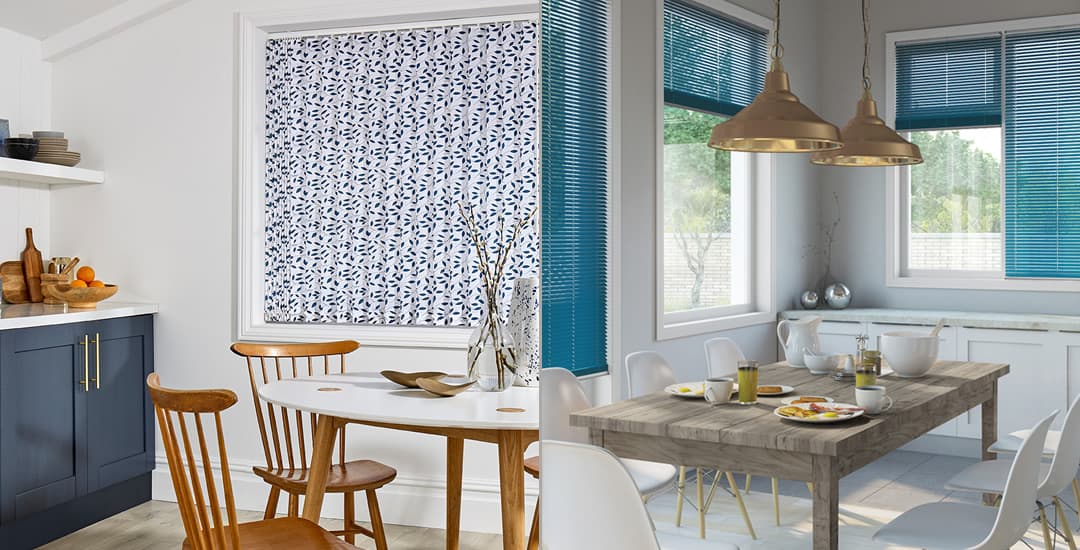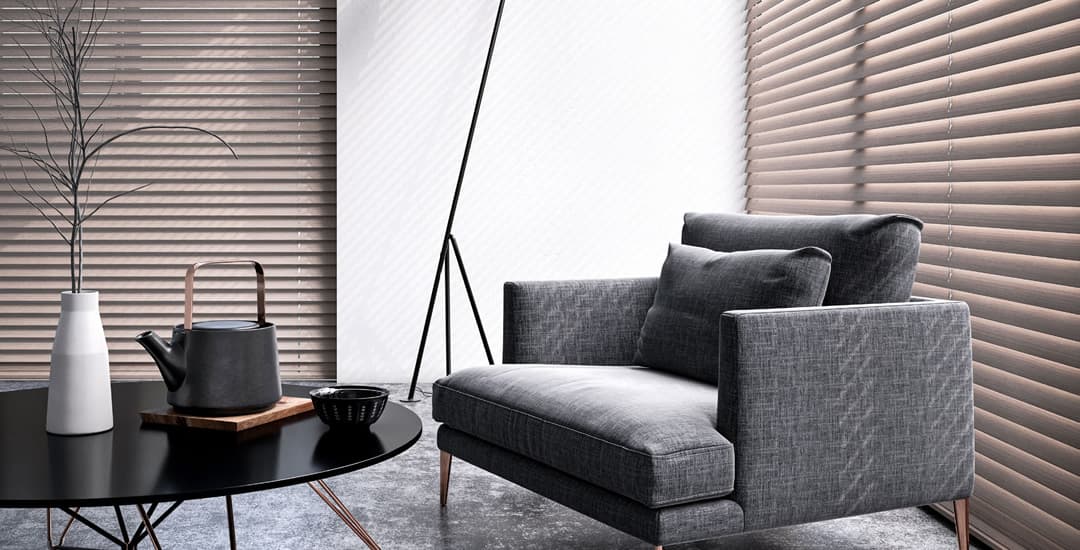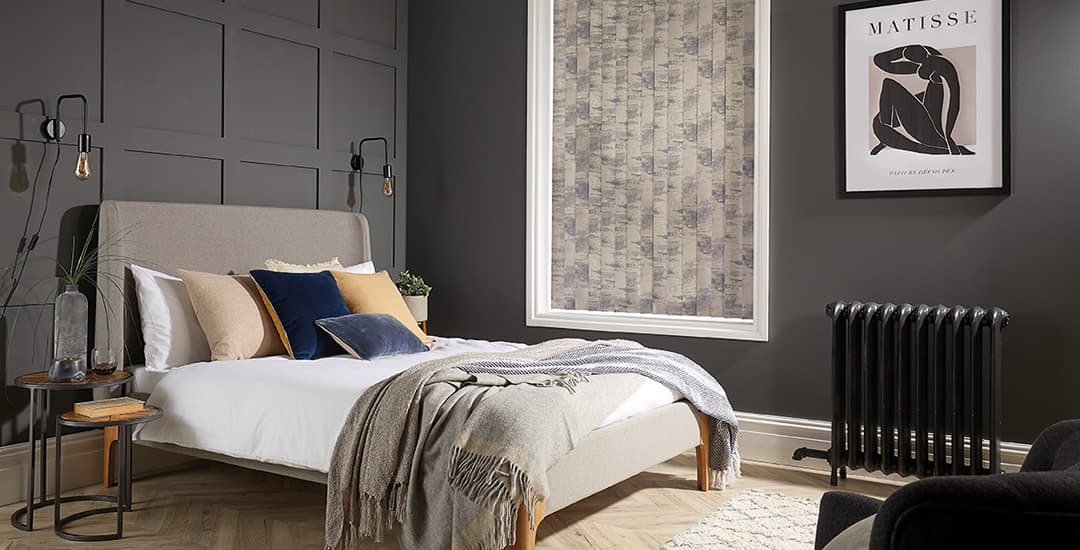
Which is best, vertical or horizontal blinds? This largely depends on what your criteria for “best” is, and what you want the blind to do. Cost, appearance, level of control over the blind, insulating properties, blackout abilities and so on may all factor into the equation for some people, while for others, something else entirely will be the deciding factor.
In this blog post I’ll compare vertical to horizontal blinds in all of their key performance areas to tell you which is best for different preferences or applications.
What are vertical and horizontal blinds respectively?
Vertical blinds are very easy to describe, and come in only one main style or design. They’re comprised of multiple long fabric louvres (strips) that hang vertically from top to bottom. The louvres contain weights at the bottom, and they’re all connected by a little chain.
The term “horizontal blinds” is a bit more obtuse, as it doesn’t really mean anything specific in blinds terms; but when people talk about horizontal blinds, they usually mean blinds that have horizontal slats.
This descriptive encompasses Venetian blinds (made of aluminium) as well as real wooden blinds and faux-wood blinds too. The fact that horizontal blinds can be made from any of these three quite different materials, each with its own pros and cons, makes the “which is best, vertical or horizontal blinds” question somewhat harder to answer, so I’ve broken it down into individual points to pick a winner for each area.
Are vertical or horizontal blinds better at filtering light?
First up, if you’ve narrowed your options down to vertical louvered blinds or horizontal slatted blinds, the chances are that filtering light and controlling your privacy by means of the blind is quite important to you.
There’s not really an overall winner here; potentially, horizontal blinds have the edge if only because vertical blind louvres are fabric and so, apt to move a little in any breeze, while horizontal blinds won’t shift once adjusted.
Are vertical or horizontal blinds better at insulating the window?

This one really depends on which type of horizontal blind you’re talking about; and I also have to throw into the mix the fact that vertical blinds can be made of either standard or thermally efficient fabrics too.
The ranking then of the most thermally efficient blinds from the available options would be:
- Faux-wood blinds (the best).
- Real wood blinds.
- Thermally efficient vertical blinds.
- Regular vertical blinds.
- Venetian blinds.
All blinds insulate the window to a degree, but Venetian blinds are probably the least effective at doing this; while choosing thermally efficient vertical blinds, faux-wood, or real wood blinds and closing them snugly would result in a noticeable difference to the comfort levels in your room if you get a significant degree of heat loss via the window.
Are vertical blinds or horizontal blinds better for humid environments?
Again, we need to tackle each of the different types of horizontal blinds individually to answer this one; and again, verticals come in two different options, being regular (polyester) fabric, or waterproof PVC/vinyl.
To kick off, neither real wood nor polyester/fabric vertical blinds are suitable for use in high humidity or damp rooms like kitchens or bathrooms.
Faux-wood blinds and waterproof verticals are both fine to use in such rooms though.
Venetian blinds are around the middle ground; their fabric lift cords aren’t waterproof while their slats are, so they would not be well suited to very steamy rooms, but would be fine in those with a more moderate level of humidity.
Which is more versatile, vertical or horizontal blinds?
Hmmm! I can only think of one scenario in which vertical blinds have an edge or can do something that the horizontals cannot manage; and that is, covering a very large or tall window.
Venetian blinds and particularly, wood and faux-wood blinds are too heavy to make in very big sizes; such as for patio doors or a floor-to-ceiling window. Vertical blinds can be made in more or less any width and drop, which is why they’re the most popular patio door blinds overall, and in some cases, the only option for large windows.
Which is better for achieving a full blackout in the room?

Vertical blinds can be made in a standard fabric or a blackout one; all three of the horizontal blinds types are made of a solid material. However, this latter point does not automatically mean that they will achieve a full blackout (not factoring light leakage around the sides of the blind depending on how you hang it).
Blackout vertical blinds will achieve a full blackout in terms of their fabric; faux-wood and real-wood blinds will also manage this or near to it, as long as they’re made with ladder tapes and not lift cords.
Lift cords pass through little holes in the slats of the blind, which admit light; and when it comes to Venetian blinds, they can only be made with lift cords and not ladder tapes, and so cannot be considered to be blackout blinds.
One final point to note about verticals here is that while their blackout variant makes each louvre impermeable to light, any gaps left when closing the blind, or if a breeze disturbs it, may admit light.
Are vertical blinds cheaper than horizontal?
This can be somewhat variable, particularly if you throw add-ons into the mix like thermally insulating, waterproof, or blackout options and so on.
But as a broad guide going from the least costly to the costliest type of blinds, you’d generally have:
- Venetian blinds (lowest cost on average).
- Vertical blinds (although, when you start getting into the realms of larger blind sizes, verticals may work out cheaper than Venetians in some cases).
- Faux-wood blinds.
- Real wood blinds.
Overall, which is best? Vertical or horizontal blinds?
There really isn’t an overall winner to be picked here, as the variables, pros and cons, and what is important to any given buyer vary so much from case to case.
As I mentioned earlier, if you’ve winnowed down your choices to a vertical or slatted horizontal blind, it’s probably the light filtering and privacy control factors that are foremost in your mind; and both types of blinds are designed specifically to do just this, so it’s pretty much a tie!




